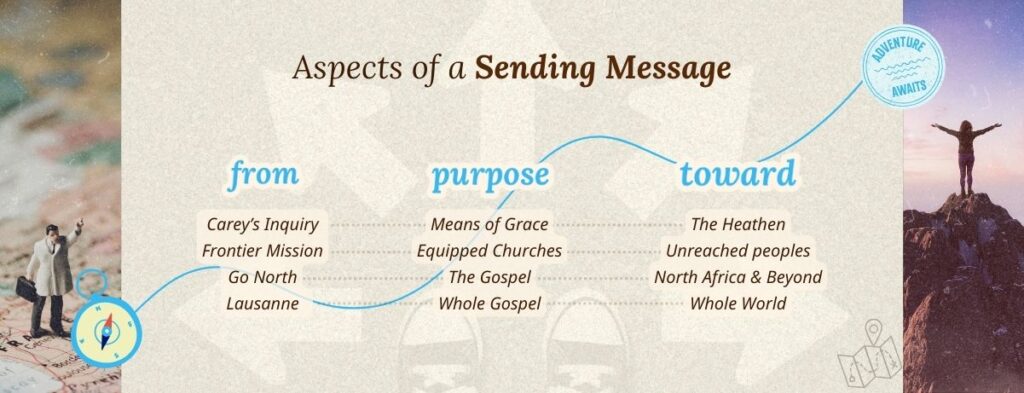The Sending Message is Key
We Still Need to Send
In the first article in this series, I argued that we still need intentional sending for the sake of the kingdom during the twenty-first century. In this article I expand on the importance of the sending message. We still need international sending, we still need intercultural sending, and now we need intentional online sending too.
We Need Information from Beyond our Comfort Zone
We can assume that life was quite comfortable for Nehemiah in Susa. He was cupbearer to the king of a large and peaceful empire—at the heart of global power and comfort. It was a shock for him to learn that ‘Those who survived the exile and are back in the province are in great trouble and disgrace. The wall of Jerusalem is broken down, and its gates have been burned with fire.’[1] That information about the situation beyond his locality is what triggered all his fasting, prayer, planning and action.
Nehemiah first ‘sent’ his own prayers.[2] His prayers were addressed to God, of course, but all his concern and his passion were with his people, not only those he could see around him, but those in and around distant Jerusalem which he had never seen in his life. Then he persuaded the king to send him with an armed escort to Jerusalem and authority for abundant resources.[3] And when he arrived (following a survey) he sent the Jews to specific locations around the broken down walls of Jerusalem.[4]
Nehemiah ensured that each section was equally addressed and everyone had equal opportunity to participate in the work.[5] Most Christians, whether Western or non-Western, intuitively feel the world to be largely Christian—because their own world is indeed largely populated by Christians, real or nominal. Only information about the context beyond their nation and people can open their eyes to the real state of the world. Such information can also put their own situation into context.

Most of Us Need More Than Information—We Need a Message
A man like Nehemiah can take some simple information, understand its kingdom significance and respond to God in prayer, understanding that the status quo is not acceptable to God, and that some sort of movement is needed to change the situation. He asked the king to send him, with resources.[6] Most of us are more like the Jews in Jerusalem and the surrounding area. They had got used to the current situation. Every day they saw the broken walls and felt the disgrace, but every day they went about their everyday business. They needed the encouragement of hearing about God’s hand on Nehemiah. They needed Nehemiah’s exhortation to ‘Come, let us rebuild the wall of Jerusalem.’[7] They needed his organisational skill and leadership to send them to where they could be effective.[8]
God Gives Sending Messages
Being ‘sent’ was important to Jesus and to his understanding of his work.[9] When Jesus mobilized his disciples, he included a message about location. To begin with, the simple ‘follow me’ was enough. But as they got used to following him, and as fame threatened to undermine his mission, he gave them a hint of his own sending instructions from his Father: ‘Let us go somewhere else—to the nearby villages—so that I can preach there also. That is why I have come.’[10] When he sent out the twelve, he gave them these specific instructions about location–’Do not go among the Gentiles or enter any town of the Samaritans. Go rather to the lost sheep of Israel . . .’[11] Then Luke tells us that ‘. . . the Lord appointed seventy-two others and sent them two by two ahead of him to every town and place where he was about to go.’[12] This implies that Jesus already knew where he was going next. Finally, there is the Great Commission which in different versions includes the sending instructions to ‘all the world’, ‘all creation’, ‘all nations’, ‘in Jerusalem, and in all Judea and Samaria, and to the ends of the earth.’[13] These remain our overall mandate, and until there is equality, the obligation remains for the whole church to continue sending to the whole world.
A Sending Message Can Have Three Main Aspects
Usually the most prominent component of a sending message is the ‘to’—where are we encouraging people to send their resources or themselves?

Then there is the ‘purpose’—why are we encouraging some to go? What is the desired outcome of sending or going? What are the methods? Finally, there is the ‘from’—from where should we go, or be sent? In the past this has often been entirely neglected or ‘taken as read’. But, as we shall see, in a polycentric world it becomes increasingly important.
Sending Messages have been Crucial to the Spread of the Gospel
William Carey
Carey’s gentle, carefully reasoned message[14] was a key factor in triggering a massive expansion of the gospel beyond Europe and North America. Once he arrived in India, Carey’s own holistic or integral approach to his work was well in line with Lausanne’s broad understanding of kingdom work. To this day it wins him praise from Bengalis who do not otherwise have a good word to say about the British occupation.
Frontier Mission
The frontier mission movement, popularised through the course ‘Perspectives on the World Christian Movement’ has a sending message with a clear ‘to’ and a clear ‘purpose’. The ‘from’ is much less clear, as is the case with many sending messages. That could be considered a weakness, but it may have become something of a strength. By tying neither the ‘to’, nor the ‘from’ to geography, this sending message has deftly uncoupled from ‘the West to the Rest’. Although pioneered and promoted from North America (and retaining some signs of that culture) it has allowed ownership to transcend geography. It has, for instance, enabled MANI (Movement for African National Initiatives) and COMIBAM (Cooperación Misionera Iberoamericana) to take the concepts and apply them in their own situation, enabling them to participate in world mission on their own terms. The frontier mission concept has also encouraged internal, national mission, where appropriate. Christians in countries such as Ethiopia, India and Indonesia have engaged energetically in cross-cultural mission within their own nations. Having identified many unreached peoples within their borders, national efforts can be prioritised, freed from the concept that mission must be international. On the other hand, countries with relatively more Christians (such as many in South America), responding to the same sending message, find few ‘unreached peoples’ within their borders and are therefore encouraged into international mission.
Go North!
I don’t know the history of this sending message. The MANI Conference of 2011 in Nigeria may have helped to popularise it across Africa. But it may have started as a call to the Nigerian churches when NEMA (Nigeria Evangelical Missions Association) launched Vision 50/15. The goal and emphasis was to mobilise the Nigerian Church for the Gateway to North Africa (Sahel), North Africa and beyond. My observation is that it is a powerful message to energise many evangelical Africans to this day. The key observation of the global context is the massive difference, the inequality, between sub-Saharan Africa and North Africa. Most sub-Saharan countries are more than 70% ‘Christian’. Most North African countries are less than 7% ‘Christian’— many less than 1%. This highlights a tremendous opportunity for Africans to evangelise Africa—by going North.
Lausanne
I have included Lausanne’s ‘Whole church, whole gospel, whole world’ as my final example of a sending message. Without specifying or encouraging any specific direction, it nevertheless can be a call by which all other sending messages can be judged and integrated. I will return to this point in my next article.

We Should Be Aware of Sending Messages
The concept of a sending message allows us to be more aware of the messages, whether explicit or implied, that different people are promoting. It enables us to critique them with more care, to look for synergy between messages, and to consider better ways of developing and promoting them in an integrated way. With God’s help this might even hasten the whole church taking the whole gospel to the whole world. Let me look at a few more current and recent messages.
‘Mission is From Everyone to Everywhere’ is a great weapon to tear down the ‘from the West to the rest’ mission mindset that is inevitably bound up with colonialism and empire. But, beyond that, what practical help does it give us in our polycentric situation?
The ‘Integral Mission’ framework seems to focus on the ‘purpose’, but I am not aware of a directional emphasis either of ‘from’ or ‘to’, which probably reduces its motivational power. Would it be helpful for integral mission to pay more attention to the ‘from’ and ‘to’?
The curtains may be closing on ‘the 10/40 window’. Many are glad about that because they saw it as too simplistic. But it was (and still is in some quarters) a powerful motivational message for mission, with its simple message, reinforced in different ways, and with a strong emphasis on the ‘to’. I guess that many were drawn into mission in the first place because they heard that clear sound. Many agencies and support organisations of various kinds were able to cooperate and collaborate on a shared understanding of the context. It stimulated prayer movements to be involved in praying for mission. It provided a welcome focus for some funders. What can we learn from that experience for future sending messages?
Our evangelical relief agencies have an intrinsic sending message not unlike Paul’s message to the Corinthians, which can be characterised in simplest terms as money from rich Christians to the poor of the world—Christian or not. The message remains a thoroughly Biblical underpinning to the work as a whole: ‘Remember the poor!’[15] One can also use the study of sending messages to examine some general shifts over time, among these the tendency of the declared purpose of sending to shift from ‘preach the gospel’ to ‘plant churches’ to ‘make disciples’. Is that progressive shift Biblical, and what does it mean for mission in general?
The ‘Sending’ of Prayer is Easily Neglected
I have been thinking that a gradual separation since then between mission and corporate prayer may have been as detrimental as the more widely remarked separation between evangelism and social action.
Teaching about William Carey often emphasises his innovative invention of the ‘mission society’ at the start of the 1800s. But in his book, he is careful to put ‘fervent and united prayer’ as the first of his two proposed actions. The society is the second.
I have been thinking that a gradual separation since then between mission and corporate prayer may have been as detrimental as the more widely remarked separation between evangelism and social action. Thankfully, in my own experience, I see them reuniting. Thanks be to God.
Operation World’s prayer calendar is an example of specific prayer sending, as is Joshua Project’s ‘Unreached of the Day’. They take us beyond our own sort of people and our own nation. Giving direction to our prayers in this way is so valuable.

A Good Sending Message Needs Prayerful Development
Prayer is also essential during the crafting of the messages themselves. This is not always obvious. But we should remember Jesus’ words that ‘. . . he who does not gather with me, scatters.’[16] Hudson Taylor’s booklet China’s Spiritual Need and Claims[17] contained and was based squarely on statistics, yet he himself tells how ‘every paragraph was steeped in prayer’[18].
Some researchers make the mistake of thinking that they can just present data. But relatively few people can look at data and understand what it means, still less what God is saying through it
In modern times, the best and most effective sending messages have always been informed and supported by data. At the heart of William Carey’s 87-page Enquiry of 1792 is a 24-page data table ‘containing a survey of the present state of the world’. Intrinsic to Hudson Taylor’s 1865 China: Its Spiritual Need and Claims[19] are several tables, charts and a map of China, yet the data is not in itself the message. Both Carey and Taylor were careful to spell out their sending message in words—with spiritual, rational and emotional appeals to their readers. Some researchers make the mistake of thinking that they can just present data. But, as with the Jews of Nehemiah’s time, relatively few people can look at data and understand what it means, still less what God is saying through it.
When developing a sending message, it is good to take several different inputs. Charles Van Engen’s reflective model[20] is a useful guide. It proposes four ‘domains’ that should inform any mission theology —the Bible, the church’s reflection, the context (which is where data becomes appropriate), and our personal experience.
William Carey’s Enquiry reveals all of these at work. He starts with a careful Bible exposition, moves on to consider the work of mission in the church through the ages, then examines the current context of the world through carefully selected data. Finally, as he moves towards his conclusions, he brings his own particular experience to bear—of answers to prayer, for instance, and of ordinary people’s ability to put small sums of money aside regularly.
And all must be ‘soaked in prayer’ if we are to be sure of working with our Master.
In a Polycentric World There Can Be No Global Sending Message
But how can we craft a message suitable for this polycentric world? Such a simple, global question may not be the best question in a polycentric world, and there may not be a simple, global answer. That is the nature of polycentrism, which will be the main topic of my next article.
Endnotes
- Nehemiah 1:3
- Nehemiah 1:4-11
- Nehemiah 2:5-9
- Nehemiah 2:17
- Nehemiah 3
- Nehemiah 2:5 ‘let him send me’. Nehemiah 2:7-8 ‘may I have letters … so that they will provide me safe-conduct … may I have a letter … so he will give me timber’.
- Nehemiah 2:17
- The outcome is seen in Nehemiah 3.
- Matthew 10:40, Luke 4:18 and John 4:34
- Mark 1:38. My italics.
- Matthew 10:5-6.
- Luke 10:1
- See Mark 16:15, Matthew 28:19, Luke 24:47 and Acts 1:8
- William Carey, An Enquiry Into the Obligations of Christians to Use Means for the Conversion of the Heathens in which the Religious State of the Different Nations of the World, the Success of Former Undertakings, and the Practicability of Further Undertakings, are Considered. (Ann Ireland, Leicester,1792).
- Eg Galatians 2:10
- Matthew 12:30
- James Hudson Taylor, China: Its Spiritual Need and Claims, 1st ed. (London: James Nisbet, 1865).
- J. Hudson Taylor, “The Call to Service,” A Retrospect, Overseas Missionary Fellowship, (n.d.) https://biblehub.com/library/taylor/a_retrospect/chapter_xviii_a_new_agency.htm
- (Taylor, 1865.)
- Charles Van Engen, Transforming Mission Theology. (William Carey Library, 2017), 25.

